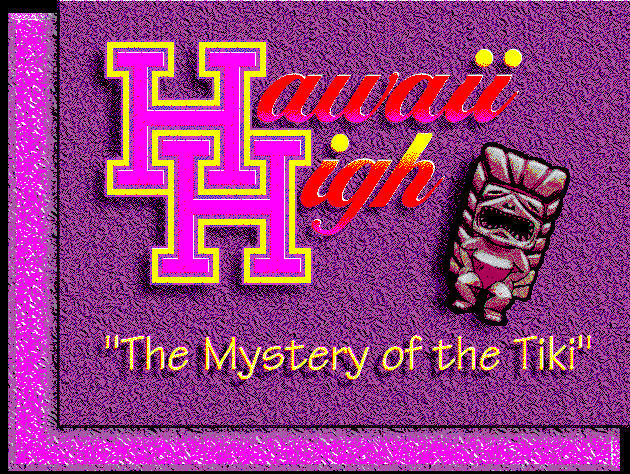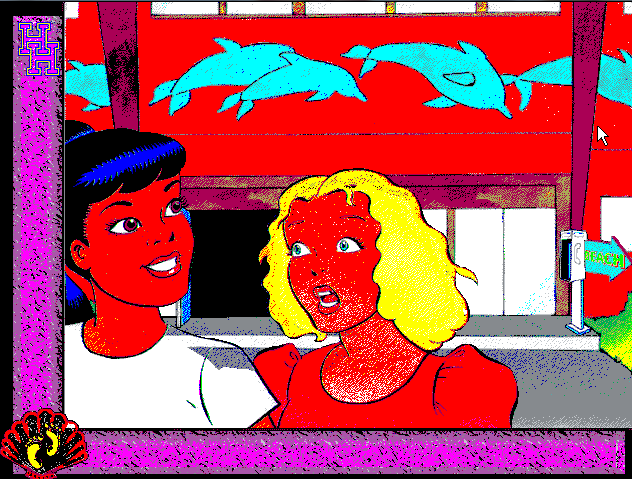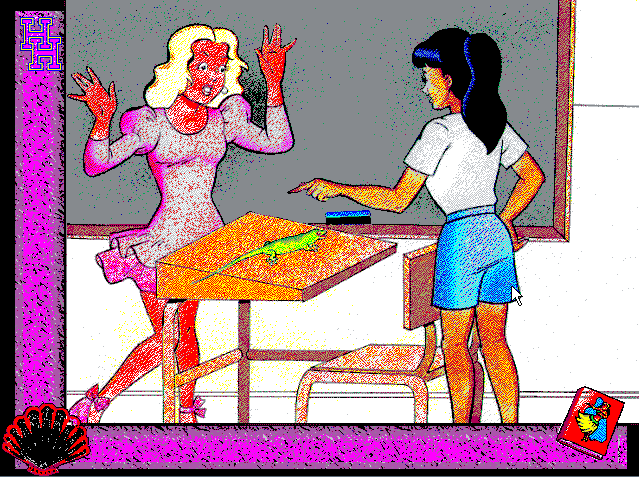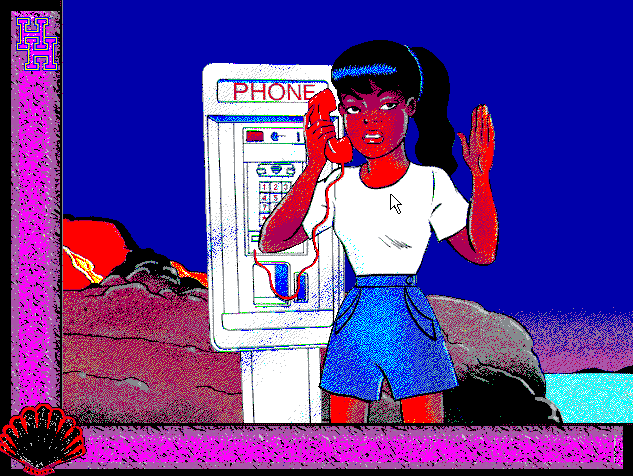Indie comics legend Trina Robbins talks about her early '90s video game for girls
Posted April 26, 2017 by Tess Young
Today I've got something really special for fans of the FEMICOM Museum: an interview with Trina Robbins. Comic geeks might recognize Robbins as an Eisner Award winning feminist icon, having written several books on the history of comics and women—decades of which she herself had a hand in making. But few realize that she also was behind a significant moment in video game history: the first video game of the "pink" games movement of the mid-1990s. Its name was Hawaii High: Mystery of the Tiki, developed and published through her friend Ken Steacy's digital media studio, Sanctuary Woods. While Hawaii High was generally recognized as a commercial flop, it marked the beginning of a quiet but powerful era of videogaming for girls.

After the infamous crash and rebirth of video games from 1983-85, developers and marketers started narrowing their focus from family entertainment to strictly young men and boys, leaving girls high and dry for nearly a decade. But all of a sudden, in the mid-1990s, a handful of developers caught on that half of the potential video game market was completely untapped. So began the pink games movement, which spawned the likes of Purple Moon Studios, Theresa Duncan's games, Her Interactive, and Mattel Interactive. But before all of them, there was Hawaii High.
Hawaii High is a point-and-click adventure style game starring a young lady who moves to Hawaii from the mainland. After befriending a classmate who is also a knowledgeable local, the game evolves from a Hawaiian Mean Girls to full-on Indiana Jones, as the two girls stumble upon a criminal plot to steal precious protected artifacts from the island. Throughout the adventure, the player is peppered with facts about Hawaii including its geography, local wildlife, and history. Despite this, Hawaii High can't be dismissed as merely an educational software title because there are just as many action-packed elements; one moment you're getting dressed up and sneaking out of your parents house to have a beachside luau with your best friend, the next moment you're decoding hieroglyphics and running through a maze overflowing with lava.

One of the first things I learned while speaking to Robbins was that Hawaii High did not actually start out as a video game. Once upon a time, it was just another comic Robbins was trying to pitch.
Well, there was nothing for girls in comics [...] I mean, there was nothing in TV entertainment for girls! There was nothing, period! And their excuse, for instance, for not marketing TV shows for girls... it was bizarre. They would say, "Oh the girls on Saturday night, they're all out on the mall, shopping for cosmetics." And I mean, of course it was guys who said this. Their excuse in comics: "girls don't read comics."
Of course, it had never occurred to any of them that if you give girls comics they like to read, girls will read comics. All the comics at that point were violent superhero comics, in which, you know, the protagonists were guys beating up other guys, and if girls were there, they were the girlfriend or they were a sex object. So it was easy for them to say girls don't read comics because girls didn't want to read those comics!
[...] So, you know, I never take no for an answer, and I had this idea that I'd like to do a girl's comic, with girl heroines, and it'd be an adventure, not a romance or anything, you know, a real adventure! And because I do love Hawaii, my partner and I, we go to Hawaii often, we love it, we usually go about once a year, I thought how about an adventure set in Hawaii? I could get a little bit of mysticism in there, you know, the goddess and everything. And of course it was soundly rejected because "girls don't read comics."
Robbins was frustrated with publishers and the comic industry constantly dashing her ideas on the rocks of sexist logical fallacies. In other words, business as usual: a sentiment likely shared by many in game development in the '90s and even today. Luckily, not everyone in comics was so narrow minded.
So I was complaining to my friend Ken Steacy, who is also a comic book artist and a Canadian and very sympathetic. I was complaining to him, and I told him about the comic I wanted to do, and he said, "That's like something that the people I'm working for now might be interested in!"
And I was "Hah!" you know, "no way, nobody likes this for girls." But, I wrote a proposal and I sent it to them and they were very interested, and that was Sanctuary Woods in Victoria!
And my friend Ken, he lived in Victoria, and he was doing something for them—"Victor Vector," it was called—so after that it was really pretty simple!
[The team] were all men; the only woman was the wife of the guy who owned Sanctuary Woods [...] I really don't know if they wanted something with my name on it, but they liked my concept, so they worked on it. The owner, I've forgotten his name now, very nice guy, he liked the concept, he liked my idea. Maybe they were trying for something different; it was something different.
To my surprise, Robbins revealed that the game making process—although she was in charge of the story and art, and was the only woman on the team—was fairly easygoing. (As a fellow game dev, I can't help but wish I felt the same about my own work!)
I just did what I wanted to do. I mean, they reviewed each thing but they okayed it, you know? My script, my art. I did get some help on the art because I don't know anything about animation. And the guy who helped me, he also did the poster. It was very nice, he worked in my style [...] He was very nice, he raised Saint Bernards.
[...] They wanted to add stuff, and I, just because I didn't know anything, I just said "go ahead!" And what they added was all that weird "she has to get through here, and [...]" I personally found them impossible! Maybe kids have more patience than I do! [...] although, there was a paper doll game in there where she gets dressed up for her adventure. That was mine! They didn't make that one up, I made that one up. And I had a lot of fun with that.

Although Robbins was developing her first game, she was no stranger to the appeal of dress up. In several of her books on the history of women in comics, she notes how paper dolls were an important component of many women's comics. When customers bought new issues they could cut out the included paper doll pages and dress up characters from the story. Some comics even encouraged readers to send in their own designs, including Wonder Woman, a character which Robbins herself drew for.
From Barbie to Mortal Kombat cites 1996's Barbie Fashion Designer (released two years after Hawaii High) as the game that opened the door for girls' games. Marketers and publishers could no longer turn a blind eye to Barbie Fashion Designer's staggering sales numbers, selling 500,000 copies in the first two months of release, and outselling popular titles of the time like Doom. Since then, most games for girls include some aspect of dressing up or customization.
After walking me through the process of making Hawaii High, Robbins described the aftermath post-release.
I know that it didn't sell. I mean it got great reviews, by the way! In Wired and everything! It got really good reviews! But I think that the stores just didn't know what to do with it, and I think for the most part, girls couldn't find it. It really is the same thing that happened with comics distribution. God knows there were many comics out there anyway for girls, but the few comics that were out there including the ones that I had done, the stores just didn't want to carry it or they would buy like, maybe 2, and once they had sold out those 2 they would go "Whew! Got rid of that!" and they would not reorder.
[...] Shortly after I did that, I was in Seattle for something. Oh! It was a very short—I was on a panel, it was a conference I guess, on women in video games [...] It was Microsoft in Seattle, yeah! And I stayed a little longer just to see Seattle. I stayed with my partner's sister. And she is married to a guy named John Socha [...] He does stuff with computers and video games, and he apparently is very successful and very important but I have no idea what it is he does.
And we were talking over dinner, and he pointed out that there were a couple of video games that girls really liked, and I said, "Well why aren't they marketed? So that girls will know, why aren't they marketed to girls?" and he said "Oh, because that's the kiss of death." Because if they're marketed to girls no one will want them.

Despite the disappointing results of Hawaii High's release, Robbins continued her work in comics. And while pop culture media like television, games, and comics still have a long way to go before they represent the full spectrum of consumers, she admits things have improved a lot since she started.
In comics, I chalk the revolution up to—and it really is a revolution—I see so many women selling their comics, and women just walking around buying those comics. I chalk that up to the beginning of the 21st century, and the advent of Sailor Moon. It came to America, and it was just gobbled up by girls who were so HUNGRY for something that they could like, both the TV series and the comics. And it was quickly followed by all the other manga, you know, shoujo manga, and it's all girls' stuff, and the girls love it! That's basically what made the change because when you could walk into Barnes and Noble and see teenage girls and adolescent girls sitting on the floor surrounded by manga and buying manga, you could no longer say "girls don't read comics."
There's less [prejudice] now, it's much better than it was; it's not perfect, by any means, but they were all like that, you know, what I said about TV, Saturday morning cartoons, and movies too! It was very rare in those days that you had female-oriented movies, and that includes for kids! I can't remember the name of the woman who produced "The Secret Garden"—I think of what she said because it's so perfect. When she took it to the studios, they said "only girls will watch this!" and she said "So? There's a lot of them!"
Since Hawaii High, Robbins has not made another game. Was the experience a one-and-done situation, I asked her?
No, actually, if somebody said "Would you like to design a videogame?" I'd love to. Sure!
The audio of the entire interview with Trina Robbins is available for download here.
Collection 




© 2012-2023 FEMICOM Museum
